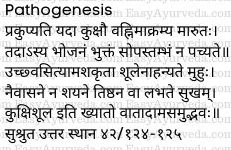Kukshi Shula Causes, Symptoms, Pathogenesis, Treatment
By Dr Raghuram Y.S. MD (Ay) & Dr Manasa, B.A.M.S
The word kukshi in general encompasses ‘hollow cavity’ inside the body. But in this context kukshi is consider as abdomen. Kukshi shula explains ‘diffuse pain in the abdomen’.
Kukshi – abdomen, abdominal cavity
Shula – colic, pain.
It is also called Kukshishoola.
Read – Shoola Types, Symptoms, Treatment, Medicines, Remedies

Table of Contents
Causes
Excessive consumption of vata aggravating foods and exposure to activities and seasons leading to aggravation of vata will lead to pathological vitiation of vata in the body.
Read – Different Causes For Vata Dosha Imbalance, Increase
Pathogenesis
- Due to the consumption of excess foods and getting exposed to the activities and seasons which cause vitiation of vata, the vata gets aggravated.
- This aggravated vata moves to the seat of agni i.e. digestive system (stomach and small intestine) and causes diminution of digestive fire.
- This vata gets further aggravated in the abdominal cavity and causes stagnation of food leading to its indigestion.
- Consequentially there is build up of ama and mala (excreta) in the gut.
- The stagnated food, indigestion, and excessive accumulation of ama and excreta repeatedly cause pain in the abdomen.
- This disease caused by vitiated vata along with ama and excreta is called kukshishula.
Symptoms
- Bhojana upastambham – consumed food would get stagnated
- Bhojanam na pachyate – food doesn’t get digested properly
- Muhuh shulah – pain in the abdomen occurs repeatedly
- Krichchra shwasa – breathing difficulty
- Na asane labhate sukham – doesn’t find comfort sitting
- Na shayane labhate sukham – doesn’t find comfort sleeping
- Na tishtane labhate sukham – doesn’t find comfort standing
Read – Parinama Shoola : Definition, Types, Treatment, Medicines
Sanskrit Verses

Treatment of KukshiShoola
Principles
Vamana or Langhana – Therapeutic emesis or lightening therapies are the treatments of choice in treating pain or colic in the abdomen. These treatments should be implemented after having considered the strength of the doshas and their intensity of vitiation.
Dipana Pachana – Powder of medicines which kindle digestion and digest ama like asafetida, rock salt and Panchakola should be mixed in buttermilk or fresh juice of pomegranate and given to drink along with samsarga pachana i.e. gruels.
Read – Deepaneeya Gana Herbs Of Charaka: Review, Benefits, Formulations
Virechana – Therapeutic purgation is one of the best treatments to deal with abdominal pain. A specific formulation explained by Master Sushruta will serve as a good purgative as well as disease specific remedy in terms of alleviating pain in the abdomen. The formulation is called Vachadi Churna. It is prepared with the below mentioned ingredients.
Vacha – Acorus calamus
Sauvarchala – Sauchal salt
Hingu – Asafetida
Kushta – Saussurea lappa
Ativisha – Aconitum heterophyllum
Abhaya – Terminalia chebula
Kutaja Bija – seeds of Holarrhena antidysenterica
This formulation should be administered after considering the strength of the doshas.
Vasti – enema with herbal oils and decoctions should be given to alleviate pain abdomen. The doshas which have accumulated should be flushed out of the gut. This will not only help in relieving pain but also will prevent recurrences. For this purpose Erandadi Taila or Higvadi Ghrta should be used for unctuous enema. Decoction enemas prepared with the same herbs may also be administered.
Nagaradi Kwatha
Decoction should be prepared with the below mentioned ingredients –
Ginger – Zingiber officinale
Dipyaka – Trachyspermum ammi
Chavya – Piper retrofractum
Hingu – asafetida
Sauvarchala – sauchal salt
Vida – vid salt
Matulunga bija – seeds of Citrus medica
Shyama bija – seeds of Operculina turpethum
Urubuka bija – seeds of Ricinus communis (castor plant)
Brhati – Solanum indicum
Kantakari – Solanum xanthocarpum
The decotion should be prepared and powder of asafetida, sauchal salt and vid salt should be sprinkled or mixed at the end and the decoction should be served fresh for drinking. This would relieve abdominal pain or colic.
Other effective measures
The below mentioned measures may be included in the treatment of abdominal pain –Upanaha – herbal poultices should be administered over the painful part of the abdomen.
Sneha – oleation / external and internal lubrication will help in relieving pain.
Seka – showering or stream pouring of medicinal liquids on the abdomen.
Dhanyamla parishechana – showering of sour fermented medicinal liquid over the abdomen
Avagaha – sitting in a tub filled with decoctions prepared with vata alleviating herbs
Anyad hitam – any other measure which alleviates abdominal pain shall be used as remedy.
Other effective formulations
Indukantham Kashayam
Gandharvahastadi Kashayam
Chitrakagrandhikadi Kashayam
Sukumaram Kashayam
Abhayarishtam
Jeerakarishtam
Putikaranjasavam
Putikasavam
Dwirutharam Churnam
Hinguvachadi Churnam
Induppukanam Churnam
Panchakola churna
Chitrakadi Vati
Kankayana Vati (Gulma)
Dashamula Haritaki
Sukumara Rasayanam
Vilwadi Leham
Yogas From Sahasra Yoga Text Book
Deepaneeya Peya
Indukantha Ghrita
Dasanga Ghrita
Sasa Vasadi Ghrita
Trikatukadi Choorna (Choorna Raja)
Kayampurandaradi Choorna
Hingu Twagadi Choorna
Karpooradi Choorna
Modakadi Choorna
Soolari Choorna
Soolahara Choorna
Swayam Bhasma
Mahavriksha Lavana
Tambula Bhasma
Vaiswanara Choorna
Dasamoolarishata
Kumaryasava
Satavari Guda
Madhusnuhi Rasayana
Pulimkuzhambu
Gudardraka
Kukkuta Rasayana
Suryaprabha Gutika
Setubhanda Matra
Paccha Endiyadi Gutika
Soolakuthara Rasa
Ananda Rasa
Kanakasundara Rasa
Anthrakuthara Rasa
Mulayiladi Kashaya
Viralveradi Kashaya
Other treatment inclusions
KukshiShoola can also be treated on the lines of treating
Shula – colic
Gulma – abdominal tumors associated with pain in flanks, heart, navel and urinary bladder
Read – Understanding Digestion Process From An Ayurveda View
Modern Correlation
In kukshi shoola we see that the condition is manifested on the backdrop of imbalance of digestive power. This leads to formation of ama i.e. intermediate products of improper digestion, indigestion of vata origin and constipation. The person will not be able to clear the faeces and there will also be accumulation of undigested food in the gut. The events are happening in the stomach, small intestine and large intestine. Sluggish digestive fire and weak digestion and formation of ama and stagnation of undigested food are the events taking place in the stomach and small intestine. At the same time constipation takes place due to the faeces not being cleared easily in the colon. This will lead to pressure in the intestines and severe pain. From the perspective of modern medicine all these events can be put together and called ‘intestinal colic’ since pain in the abdomen is the most important symptom of this disease. We can make it more precise and call it ‘intestinal colic caused due to weak digestion, stagnation of undigested food and constipation’. This will rule out other conditions which can cause pain in the abdomen.
Intestinal colic
It is a cramp like pain. It originates in the small or large intestine. It is caused by a blockage in the intestine. This in turn keeps food and liquids stagnated and prevents them from passing through the body to the outside.
The blockage can occur due to different causes which include –
- Impacted faeces / constipation
- Inflammatory diseases of the intestine like Crohn’s disease
- Formation of scar tissue in the intestines (from previous surgeries related to abdomen and pelvis)
- Inflammation or infection of diverticula
- Cancerous tumours
Symptoms
Abdominal pain
Loss of appetite
Vomiting
Loss of or lessened bowel movement
Inability to fart (pass out the gases)
Distension of abdomen
Parshva Shoola and Kukshi Shoola
Parsva Shula is a type of colic or pain manifested in the flanks – sides of the body (chest and belly). This condition is explained by Master Sushruta amongst different types of pain or colic.
The term ‘parsva’ is most often taken as ‘urah parshva’ i.e. ‘sides of the chest wall’ in clinical practice. So parsva shula confined to the pain in the sides of the chest cavity. But the sides of the abdomen are also considered in the sides of the body or trunk. Unless specified parsva means both – sides of the chest and sides of the belly. Sides of the abdomen can be considered as udara parsva, udara stands for abdomen.
Read – Shoola Types, Symptoms, Treatment, Medicines, Remedies
So there is a confusion as to what we should consider by ‘parsva shula’ – pain in the sides of the chest or ‘pain in the sides of the chest as well as sides of the abdomen’?
Read related: Parsva Shula Causes, Symptoms, Pathogenesis, Treatment, Modern View

Why this doubt?
We get this doubt because in the description of pathogenesis of parsva shula, Master Sushruta has also mentioned the obstruction of vata by kapha in kukshi i.e. abdomen and parsva i.e. sides of the chest and abdomen. Here the use of both words ‘kukshi’ and ‘parsva’ leads to confusion.
1. Is the pain in the abdomen and sides of both chest and abdomen?
2. Is the pain in the abdomen and sides of the chest?
3. Is the pain in the kukshi-parsva (if both words are taken together) i.e. sides of the abdomen?
If case 3 is considered then what was the need of explaining another painful condition called ‘kukshi shula’ which means abdominal pain or ‘intestinal colic’ by Master Sushruta immediately after explaining parsva shula?
Why would Sushruta explain ‘pain in the sides of the abdomen’ before ‘pain in the abdomen’?
Read – Parinama Shoola : Definition, Types, Treatment, Medicines
Should we consider Parsva Shula explained by Sushruta as pain in sides of chest or pain in the sides of abdomen?
The pathogenesis and symptoms of parsva shula as explained by Master Sushruta directs us to understand that this condition is caused both in the sides of the chest as well as abdomen. There are some symptoms related to the involvement of abdomen like distension, gurgling sounds in abdomen, and anorexia. At the same time we get to see the symptoms pointing towards the involvement of sides of the chest like difficulty in breathing. Pricking pain has not been specifically mentioned so as to where it occurs. We can infer that this pain occurs both in the sides of the chest as well as abdomen. Sleeplessness may be caused due to pain in both sides of the chest and abdomen.
Pain may be predominant in abdomen or chest or in both places. But the separate explanation of ‘kukshi shula’ drives us to limit the meaning of parsva shula as ‘pain in the sides of the chest’.
Read – Fullness Of Abdomen – Ayurvedic Approach And Treatment
Differences between Parsva Shula and Kukshi Shula
Master Sushruta has also explained Kukshi Shula in the same chapter. Kukshi means abdomen. We may get a doubt so as to why Master Sushruta has once again explained abdominal pain or colic separately after considering abdominal pain in the context of parsva shula a few paragraphs before kukshi shula. We can infer that –
Parsva shula is pain in the sides of the abdomen and also associated with pain in the sides of the chest. Parsva Shula is caused by vitiated kapha and vata.
Kukshi shula is pain in the abdomen, i.e. entire abdomen and is not limited to the sides of the abdomen. Kukshi shula is caused by vitiated vata. This condition has its own pathogenesis and symptoms different from that of parsva shula.
In short –
- Parsva shula is predominantly a condition presenting with pain in the sides of the chest and includes abdominal symptoms
- Kukshi shula is predominantly a condition presenting with pain in the abdomen including its sites and includes chest conditions / symptoms
We can see breathlessness in both conditions. In parsva shula it is due to the involvement of the lungs and in kukshi shula it is due to the pain referred from the intestines to the sides of the chest wall.
Read – Different Causes For Vata Dosha Imbalance, Increase
Subdivisions of Parsva Shula
Depending on the place of manifestation of pain / colic, parsva shula can be classified as –
Udara Parsva Shula – Pain in the sides of the abdomen
Urah Parsva Shula – Pain in the sides of the chest
2nd perspective of understanding parsva shula by understanding the term kukshi
The term ‘kukshi’ most often refers to abdomen or abdominal cavity. Kukshi is also considered to have the below mentioned meanings –
Womb
Cavity
If kukshi is considered a cavity it also includes the space inside the chest or thoracic cavity. In this sense the kukshi parsva mentioned in the pathogenesis of the disease by Master Sushruta can be considered as ‘sides of the chest cavity’.
- Adhmana can be considered as expansion of the chest cavity caused by vitiated kapha and vata.
- Gudagudayana can be considered as abnormal chest sounds caused due to friction.
- Suchibhiriva nistoda refers to pricking pain in the sides of the chest.
The abdominal complaints and sleeplessness can be due to the effect of long standing pain in the sides of the chest and also due to the pressure imparted by the expanded chest over the abdominal organs and organs of digestion.
In the ‘kukshi shula’ explained by Master Sushruta ‘difficulty in breathing’ has been mentioned among the symptoms. This may be due to long standing abdominal pain and imparting pressure over the chest and causing breathing trouble. In kukshi shula if there is pain in the abdomen caused due to pathology of intestines the pain may not be limited to central pain but also may include sides of the belly. In this way udara parsva shula i.e. ‘pain in the sides of the abdomen’ is also a symptom of kukshi shula.
In parsva shula pain will be first manifested in the chest sides and later would include sides of the abdomen. In kukshi shula pain will first manifest in the abdomen including its sides and later will include sides of the chest.
Considering all these points we can consider that parsva shula is an explanation of ‘pain in the sides of the chest cavity’ along with abdominal complaints or referred abdominal pain. In this context we will consider parsva shula as pain in the sides of the chest.
Read – Vedanasthapana Gana – Pain Relieving Group Of Herbs Review, Benefits

Other interesting points about Parsva Shula
Parsva Shula and Rajayakshma – Parsva shula is one of the symptoms of Rajayakshma (tuberculosis, phthisis) disease mentioned by both Master Charaka and Sushruta. This mention clearly points towards pain in the sides of the chest rather than pain in the sides of the abdomen.
Defining Parsva shula pathogenesis in Rajayakshma disease Master Charaka tells that this condition is characterized by sankocha i.e. constriction and ayama i.e. distension or pressure manifested in an uncertain / irregular way. In parsva shula sometimes there is constriction and sometimes there is expansion. Constriction is due to predominance of vata and expansion is due to predominance of kapha in the pathogenesis. Therefore the nature of pain will be unpredictable and uncertain.
Parsva Shula in Gulma – Pain in Gulma – Gulma is a disease wherein pain manifests in 5 different regions due to the presence of an abdominal tumor or an enlargement therein. Pain is present in –
- Parsva – sides of the body / flanks / sides of chest and abdomen
- Hridaya – central chest (region of heart)
- Nabhi – central part of the abdomen around the navel
- Vasti – lower part of the abdomen / region of the urinary bladder
Even in Gulma there is pain in flanks which include pain in the sides of chest as well as abdomen. This is because the central chest has been included in ‘hridaya’ and central abdomen in the term ‘nabhi’ and lower abdomen in the term ‘vasti’. But this pain is due to the presence of a tumor like swelling or cystic swelling in between the heart and navel i.e. in the abdomen. Here parsva shula is a symptom of gulma. In parsva shula and kukshi shula there is no tumor or mass in the abdomen or chest cavities.
Read – Gulma- Abdominal Tumor- A Unique Disease In Ayurveda
Parsva shula as ‘pain in the sides of the chest’
Due to the below mentioned reasons parsva shula should strictly be considered as ‘pain in the sides of the thorax – chest wall’.
Sushruta has explained kukshi shula immediately after parsva shula. Kukshi shula is ‘pain in tummy – intestinal colic’ wherein the pain is located not only in the central part of the abdomen but also in its sides.
Parsva Shula mentioned by master Charaka in the context of ‘symptoms of Rajayakshma disease’ symptoms and treatment of parsva shula therein explains ‘pain in the sides of the sides of the chest wall’.
Abdominal symptoms of parsva shula may be manifested due to the effect of the ‘pain in the sides of the chest wall’ over the abdomen. Sleeplessness too may be due to the effect of constant and ongoing chest wall pain.
The terms which denote symptoms of abdominal disease i.e. adhmana, gudagudayanam, suchibhiriva nistodam mentioned as symptoms of parsva shula should be considered as related to the chest and not in relation to the abdomen.
Click to Consult Dr Raghuram Y.S. MD (Ayu)









